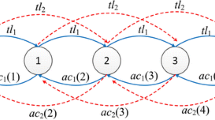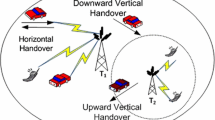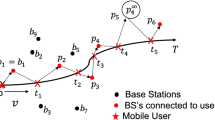Abstract
A key performance indicator of mobile wireless networks is failure probability of handover calls. In this paper, we propose a Call Admission Control policy which prioritizes handover calls over new calls in WCDMA systems. The OVSF code occupancy of the system is modeled by a Markov chain and the differentiation between handover and new calls is performed at the code level by introducing a “guard code” scheme. The scheme belongs to the well-known family of guard channel schemes and reserves some code capacity to favor the continuation of handover calls over the new calls. As the management of the general case is intractable, we solve certain numerical instances of the problem and manage to calculate several performance metrics like new call blocking and handover failure probabilities and code utilization. We complete our study with simulation results in the case of higher OVSF code tree capacity.






Similar content being viewed by others
References
O. T. W. Yu, and V. C. M. Leung, Adaptive resource allocation for prioritized call admission over an ATM-based wireless PCN, IEEE Journal on Selected Areas in Communications, Vol. 15, No. 7, pp. 1208–1225, 1997.
S. Lee, and S. Park, Handoff with dynamic guard channels in atm-based mobile networks, Proceedings of the 13th international Conference on information Networking. IEEE ICOIN, pp.21–23, January 1998.
Y. C. Kim, D. E. Lee, B. J. Lee, Y. S. Kim, and B. Mukherjee, Dynamic channel reservation based on mobility in wireless ATMnetworks, IEEE Communications Magazine, Vol. 37, No. 11, pp. 47–51, 1999.
I. C. Panoutsopoulos, S. Kotsopoulos, and V. Tountopoulos, Handover and new call admission policy optimization for G3G systems, Springer Wireless Networks, Vol. 8, No.4, pp. 381–389, 2002.
X. Cheng, B. Li, and Y. Fang, A dynamic multiple-threshold bandwidth reservation (DMTBR) scheme for QoS provisioning in multimedia wireless networks, IEEE Transactions on Wireless Communications, Vol. 4, No. 2, pp. 583–592, 2005.
T. C. Wong, J. W. Mark, and K. C. Chua, Multi-level Dynamic Guard Channels for Priority Access in Cellular Systems, NETWORKING 2005, Springer LNCS 3462, pp. 598–609.
J. Zheng, Y. Zhang, and E. Regentova, Virtual guard channel for handoff calls in integrated voice/data wireless networks, IEEE Communications Letters, Vol. 10, No. 10, pp. 263–266, 2006.
3GPP, Technical Specification TS V5.2.0, Spreading and Modulation (FDD), 2002–2009.
F. Adashi, M. Sawahashi, and K. Okawa, Tree structured generation of orthogonal spreading codes with different lengths for forward link of DS-CDMA mobile radio, Electronic Letters, Vol. 33, pp. 27–28, 1997.
Y.-C. Tseng, and C.-M. Chao, Code placement and replacement strategies for wideband CDMA OVSF code tree management, IEEE Transactions on Mobile Computing, Vol. 1, No. 4, pp. 293–302, 2002.
Author information
Authors and Affiliations
Corresponding author
Rights and permissions
About this article
Cite this article
Skoutas, D.N., Abd El-atty, S.M. & Rouskas, A.N. A Guard Code Scheme for Handover Traffic Management in WCDMA Systems. Int J Wireless Inf Networks 15, 98–104 (2008). https://doi.org/10.1007/s10776-008-0076-7
Received:
Accepted:
Published:
Issue Date:
DOI: https://doi.org/10.1007/s10776-008-0076-7




